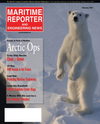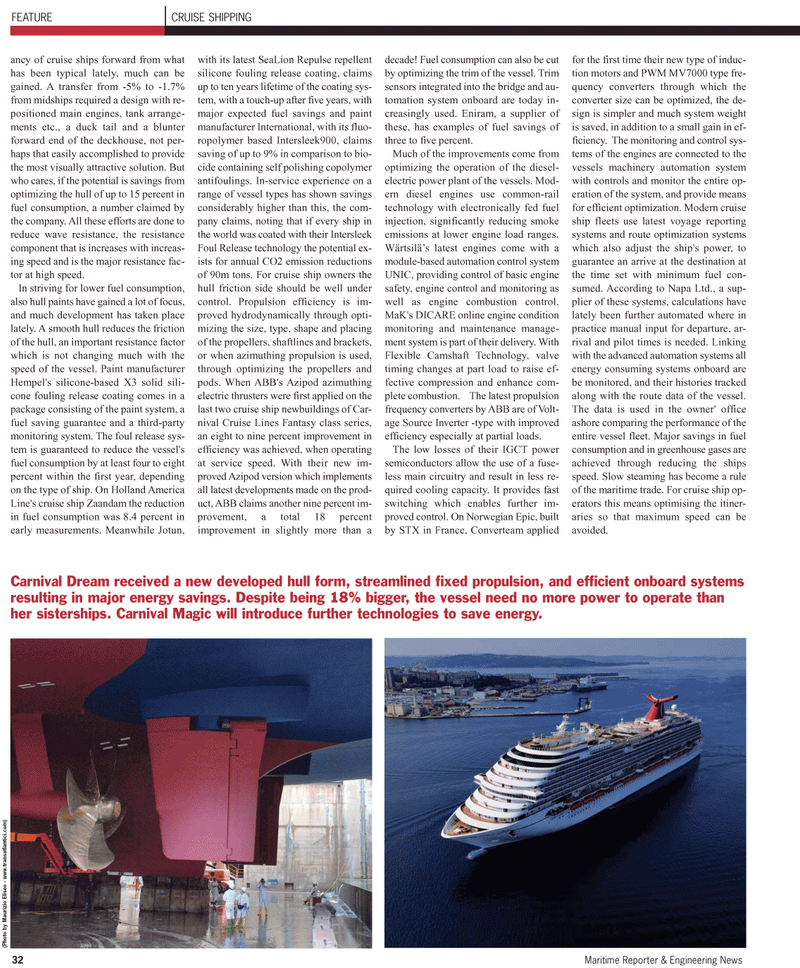
Page 32: of Maritime Reporter Magazine (February 2011)
Cruise & Passenger Vessel Annual
Read this page in Pdf, Flash or Html5 edition of February 2011 Maritime Reporter Magazine
32 Maritime Reporter & Engineering News
FEATURE CRUISE SHIPPING ancy of cruise ships forward from what has been typical lately, much can be gained. A transfer from -5% to -1.7% from midships required a design with re- positioned main engines, tank arrange- ments etc., a duck tail and a blunter forward end of the deckhouse, not per- haps that easily accomplished to provide the most visually attractive solution. But who cares, if the potential is savings from optimizing the hull of up to 15 percent in fuel consumption, a number claimed by the company. All these efforts are done to reduce wave resistance, the resistance component that is increases with increas- ing speed and is the major resistance fac- tor at high speed.
In striving for lower fuel consumption, also hull paints have gained a lot of focus, and much development has taken place lately. A smooth hull reduces the friction of the hull, an important resistance factor which is not changing much with the speed of the vessel. Paint manufacturer
Hempel's silicone-based X3 solid sili- cone fouling release coating comes in a package consisting of the paint system, a fuel saving guarantee and a third-party monitoring system. The foul release sys- tem is guaranteed to reduce the vessel's fuel consumption by at least four to eight percent within the first year, depending on the type of ship. On Holland America
Line's cruise ship Zaandam the reduction in fuel consumption was 8.4 percent in early measurements. Meanwhile Jotun, with its latest SeaLion Repulse repellent silicone fouling release coating, claims up to ten years lifetime of the coating sys- tem, with a touch-up after five years, with major expected fuel savings and paint manufacturer International, with its fluo- ropolymer based Intersleek900, claims saving of up to 9% in comparison to bio- cide containing self polishing copolymer antifoulings. In-service experience on a range of vessel types has shown savings considerably higher than this, the com- pany claims, noting that if every ship in the world was coated with their Intersleek
Foul Release technology the potential ex- ists for annual CO2 emission reductions of 90m tons. For cruise ship owners the hull friction side should be well under control. Propulsion efficiency is im- proved hydrodynamically through opti- mizing the size, type, shape and placing of the propellers, shaftlines and brackets, or when azimuthing propulsion is used, through optimizing the propellers and pods. When ABB's Azipod azimuthing electric thrusters were first applied on the last two cruise ship newbuildings of Car- nival Cruise Lines Fantasy class series, an eight to nine percent improvement in efficiency was achieved, when operating at service speed. With their new im- proved Azipod version which implements all latest developments made on the prod- uct, ABB claims another nine percent im- provement, a total 18 percent improvement in slightly more than a decade! Fuel consumption can also be cut by optimizing the trim of the vessel. Trim sensors integrated into the bridge and au- tomation system onboard are today in- creasingly used. Eniram, a supplier of these, has examples of fuel savings of three to five percent.
Much of the improvements come from optimizing the operation of the diesel- electric power plant of the vessels. Mod- ern diesel engines use common-rail technology with electronically fed fuel injection, significantly reducing smoke emissions at lower engine load ranges.
Wärtsilä’s latest engines come with a module-based automation control system
UNIC, providing control of basic engine safety, engine control and monitoring as well as engine combustion control.
MaK's DICARE online engine condition monitoring and maintenance manage- ment system is part of their delivery. With
Flexible Camshaft Technology, valve timing changes at part load to raise ef- fective compression and enhance com- plete combustion. The latest propulsion frequency converters by ABB are of Volt- age Source Inverter -type with improved efficiency especially at partial loads.
The low losses of their IGCT power semiconductors allow the use of a fuse- less main circuitry and result in less re- quired cooling capacity. It provides fast switching which enables further im- proved control. On Norwegian Epic, built by STX in France, Converteam applied for the first time their new type of induc- tion motors and PWM MV7000 type fre- quency converters through which the converter size can be optimized, the de- sign is simpler and much system weight is saved, in addition to a small gain in ef- ficiency. The monitoring and control sys- tems of the engines are connected to the vessels machinery automation system with controls and monitor the entire op- eration of the system, and provide means for efficient optimization. Modern cruise ship fleets use latest voyage reporting systems and route optimization systems which also adjust the ship's power, to guarantee an arrive at the destination at the time set with minimum fuel con- sumed. According to Napa Ltd., a sup- plier of these systems, calculations have lately been further automated where in practice manual input for departure, ar- rival and pilot times is needed. Linking with the advanced automation systems all energy consuming systems onboard are be monitored, and their histories tracked along with the route data of the vessel.
The data is used in the owner' office ashore comparing the performance of the entire vessel fleet. Major savings in fuel consumption and in greenhouse gases are achieved through reducing the ships speed. Slow steaming has become a rule of the maritime trade. For cruise ship op- erators this means optimising the itiner- aries so that maximum speed can be avoided.
Carnival Dream received a new developed hull form, streamlined fixed propulsion, and efficient onboard systems resulting in major energy savings. Despite being 18% bigger, the vessel need no more power to operate than her sisterships. Carnival Magic will introduce further technologies to save energy. (Photo by Maurizio Eliseo - www .transatlantici.com)

 31
31

 33
33
